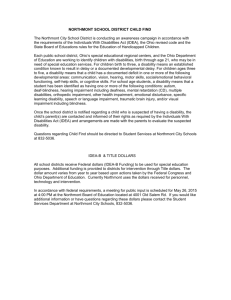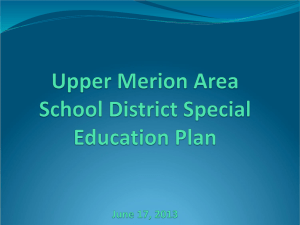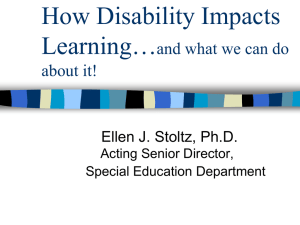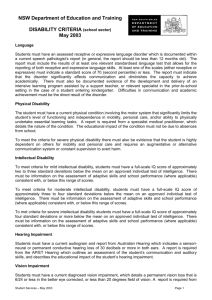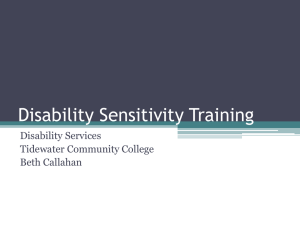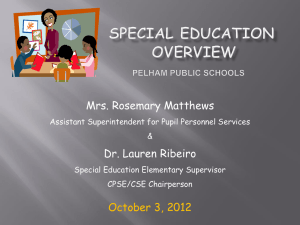education, arts, and humanities cabinet
advertisement
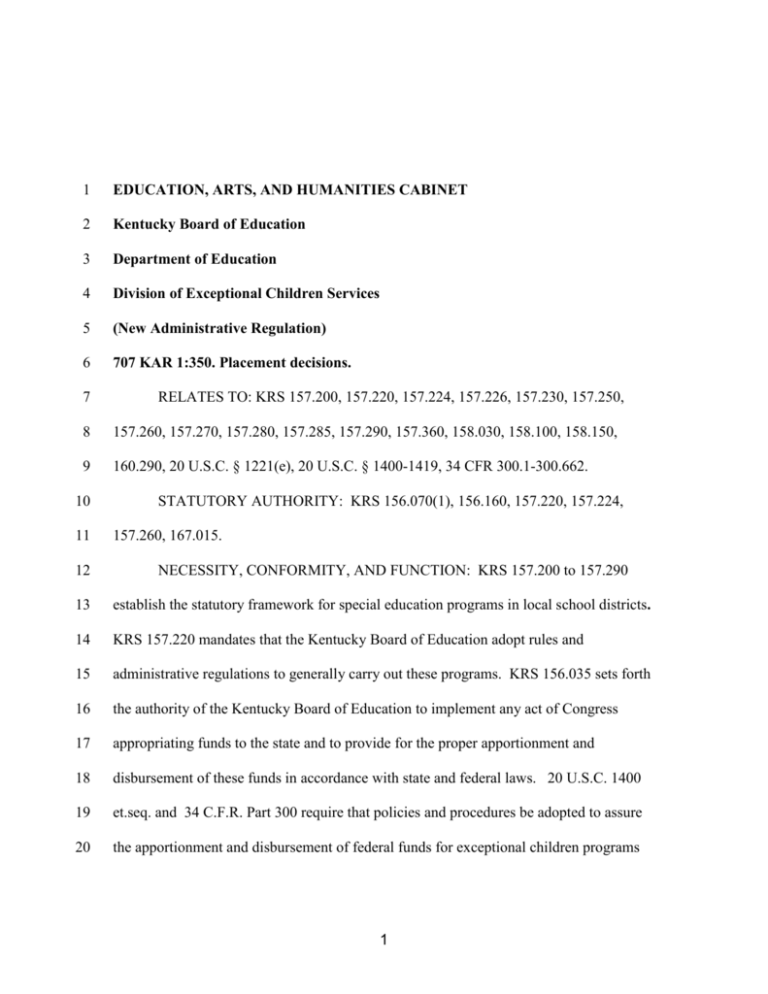
1 EDUCATION, ARTS, AND HUMANITIES CABINET 2 Kentucky Board of Education 3 Department of Education 4 Division of Exceptional Children Services 5 (New Administrative Regulation) 6 707 KAR 1:350. Placement decisions. 7 RELATES TO: KRS 157.200, 157.220, 157.224, 157.226, 157.230, 157.250, 8 157.260, 157.270, 157.280, 157.285, 157.290, 157.360, 158.030, 158.100, 158.150, 9 160.290, 20 U.S.C. § 1221(e), 20 U.S.C. § 1400-1419, 34 CFR 300.1-300.662. 10 11 12 STATUTORY AUTHORITY: KRS 156.070(1), 156.160, 157.220, 157.224, 157.260, 167.015. NECESSITY, CONFORMITY, AND FUNCTION: KRS 157.200 to 157.290 13 establish the statutory framework for special education programs in local school districts. 14 KRS 157.220 mandates that the Kentucky Board of Education adopt rules and 15 administrative regulations to generally carry out these programs. KRS 156.035 sets forth 16 the authority of the Kentucky Board of Education to implement any act of Congress 17 appropriating funds to the state and to provide for the proper apportionment and 18 disbursement of these funds in accordance with state and federal laws. 20 U.S.C. 1400 19 et.seq. and 34 C.F.R. Part 300 require that policies and procedures be adopted to assure 20 the apportionment and disbursement of federal funds for exceptional children programs 1 1 in accordance with applicable laws. This administrative regulation establishes 2 requirements for making placement decisions about children with disabilities. 3 Section 1. Placement decisions. (1) A LEA shall ensure that to the maximum 4 extent appropriate, children with disabilities are educated with children who are 5 nondisabled. The LEA shall ensure that special classes, separate schooling or other 6 removal of children with disabilities from the regular educational environment occurs 7 only if education in the regular education environment with the use of supplementary aids 8 and services cannot be satisfactorily achieved due to the nature or severity of the 9 disability. 10 11 (2) A LEA shall ensure that a continuum of alternative placements is available to meet the needs of children with disabilities for special education and related services. 12 (3) The continuum shall include the alternative placements of: 13 (a) instruction in regular classes; 14 (b) special classes; 15 (c) special schools; 16 (d) home instruction; and 17 (e) instruction in hospitals and institutions. 18 (4) The LEA shall make provision for supplementary services to be provided in 19 20 conjunction with regular class placement. (5) In determining the educational placement of a child with a disability, the LEA 21 shall ensure that the placement decision is made by the ARC in conformity with the least 22 restrictive environment provisions. 23 (6) A child’s placement shall be: 2 1 (a) determined at least annually; 2 (b) based on the child’s IEP; and 3 (c) as close as possible to the child’s home. 4 (7) Unless the IEP of a child with a disability requires some other arrangement, the 5 child shall be educated in the school that he would attend if nondisabled. 6 7 (8) In selecting the least restrictive environment, consideration shall be given to any potential harmful effects on the child or on the quality of services that he needs. 8 9 (9) A child with a disability shall not be removed from education in age-appropriate regular classrooms solely because of needed modifications in the general curriculum. 10 (10) In providing or arranging for the provision of nonacademic and extracurricular 11 services and activities, a LEA shall ensure that a child with a disability participates with 12 nondisabled children in those services and activities to the maximum extent appropriate 13 to the needs of the child. 14 15 Section 2. Class size. (1) A LEA shall provide special education according to caseload for special classes for each child with a disability as follows: 16 (a) emotional-behavior disability is eight (8); 17 (b) functional mental disability is ten (10); 18 (c) hearing impairment is six (6); 19 (d) mild mental disability for primary is fifteen (15) and for secondary is fifteen 20 (15); 21 (e) multiple disabilities is ten (10); 22 (f) orthopedic impairment is sixteen (16); 23 (g) other health impairment is sixteen (16); 3 1 2 (h) specific learning disability for primary is ten (10) and for secondary is fifteen (15); and 3 (i) visual impairment is ten (10). 4 (2) A LEA shall provide special education according to class size for resource 5 classes for each child with a disability as follows: 6 (a) emotional-behavior disability is eight (8); 7 (b) functional mental disability is eight (8); 8 (c) hearing impairment is eight (8); 9 (d) mild mental disability is ten (10); 10 (e) multiple disabilities is eight (8); 11 (f) orthopedic impairment is ten (10); 12 (g) other health impairment is ten (10); 13 (h) specific learning disability is ten (10); and 14 (i) visual impairment is eight (8). 15 (3) Children with disabilities that meet the definition of autism; deaf-blindness; 16 developmental delay for ages six (6), seven (7), and eight (8); and traumatic brain injury 17 shall be served in regular classes, special classes, or resource classes as determined by the 18 ARC. 19 (4) If a teacher of exceptional children provides services through the collaborative 20 model, the maximum caseload shall not exceed twenty (20) children with disabilities for 21 secondary, and fifteen (15) children with disabilities for primary. 22 23 (5) Pursuant to KRS 157.360, if caseload for special classes or class size for resource classes exceeds the maximum specified in this section for thirty (30) days, a 4 1 2 LEA shall submit a waiver request to the Kentucky Department of Education. Section 3. Case load for resource teachers. Case load for resource teachers refers 3 to maximum number of student records for whom a teacher can be assigned. A LEA 4 shall make those assignments based on the following: 5 (1) emotional-behavioral disability is fifteen (15); 6 (2) functional mental disability is ten (10); 7 (3) hearing impairment is eight (8); 8 (4) mild mental disability for primary is fifteen (15) and for secondary is twenty 9 (20); 10 (5) multiple disabilities is ten (10); 11 (6) orthopedic impairment is twenty (20); 12 (7) other health impairment is twenty (20); 13 (8) specific learning disability for primary is fifteen (15) and for secondary is twenty 14 15 (20); and (9) visual impairment is ten (10). 5 This is to certify that the chief state school officer has reviewed and recommended this proposed administrative regulation prior to its adoption by the Kentucky Board of Education, as required by KRS 156.070(4). __________ Date __________ Date __________ Date Kevin M. Noland, Interim Commissioner Kentucky Department of Education Helen Mountjoy, Chairperson Kentucky Board of Education APPROVED AS TO FORM Kevin M. Noland, Attorney 6 PUBLIC HEARING: A public hearing on this proposed administrative regulation shall be held May 26, 2000, at 10:00 a.m. in the State board Room, First Floor, Capital Plaza Tower, 500 Mero Street, Frankfort, Kentucky. Individuals interested in being heard at this meeting shall notify this agency in writing by May 19, 2000, five working days prior to the hearing, of their intent to attend. If no notification of intent to attend the hearing is received by that date, the hearing may be canceled. This hearing is open to the public. Any person who wishes to be heard will be given an opportunity to comment on the proposed administrative regulation. A transcript of the public hearing will not be made unless a written request for a transcript is made. If you do not wish to be heard at the public hearing, you may submit written comments on the proposed administrative regulation. Send written notification of intent to be heard at the public hearing or written comments on the proposed administrative regulation to Mr. Kevin M. Noland, Associate Commissioner, Office of Legal Services, Department of Education, 500 Mero Street, First Floor, Capital Plaza Tower, Frankfort, Kentucky, 40601, phone 502/564-4474, fax 502/564-9321. 7 8
